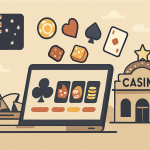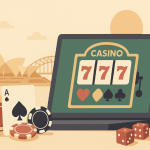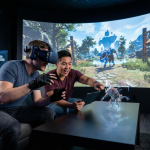Online Bridge lets you fail a thousand times in private—no sighs, no judgment, just pure, endless practice. But at the real card table? Every twitch, every glance, every snap of the cards creates lessons your brain never forgets.
Learning Bridge in Real Life vs. Online

Learning Bridge in Real Life vs. Online
The way people learn games these days is quietly interesting. Once played in quiet clubs on well-kept wooden tables, bridge can now be played with just a few clicks. Online platforms let players start a match right away, without having to wait, set up, or make small talk. It’s a lot like exploring casinos without registration, where the usual sign-up forms are skipped in favor of instant play and smooth entry into the game itself.
But what happens when you switch this easy world for the real one, with real cards being shuffled, bidding boxes being heavy, and a green table being tense? Really, does one way teach better than the other? Or do they just help you get better at different things?
Now it’s time to break this down right.
The charm (and challenge) of learning Bridge in real life
Everything changes when you’re playing against a real person. They smirk, cough, and twitch their eyes in ways that the screen never will. Sometimes playing Bridge in person makes you feel like you’re part of a small group of people who like to think and plan. The cards snapping on the table and whispers when someone makes a strange bid are all part of the old-school fun.
Mistakes here sting more because someone saw you make them. Your partner might glance sideways, that silent universal code for “really… that bid?” But this sting is good. It carves lessons deep into memory. You remember your wrong moves not because the app beeped, but because someone chuckled softly across the table.
And the slow pace? Surprisingly effective. Your brain soaks in rules, strategy, weird exceptions—all without digital rushing. You marinate in the game.
As well, face to face bridge games often end with a post mortem over a coffee or beer at a local establishment. Not only does that improve your game and your partnerships, it’s also social. The social aspects of bridge are what makes it such an amazing game and so good for your brain plasticity!
The slick, shiny appeal of online bridge
And then there’s online bridge. No heavy table. No worried glances. No hushed murmurs. Just you, a quiet screen, and an endless supply of practice hands.
Online Bridge gives you freedom to fail a thousand times in private. You can pause. You can replay. The bots don’t sigh. Your self-esteem stays intact while your skills secretly improve.
Plus, like those handy casinos without registration, online Bridge saves you time and awkwardness. No need to arrange a foursome or find an open club. It’s Bridge in your pajamas. Bridge at 2 AM. Bridge while waiting for your pasta to boil. It lets you put in crazy amounts of quiet repetition—and that matters when you’re building memory.
But this comfort comes at a cost. You miss the signals that only human opponents give. You can’t learn to read discomfort in a partner’s face, or bluff with a raised eyebrow. Online is clean and fast… but sterile. It polishes your tactics, not your table instincts.
So… which teaches you better?
Honestly? Neither on its own. The best Bridge players seem to switch between both worlds without fuss or overthinking.
But living in only one world for too long will twist your skillset. Stay offline forever, and modern online tactics—fast bidding systems, quirky leads—can leave you blinking, confused. Play online only, and sitting across from a partner who sighs or rolls their eyes can shatter your confidence.
Here’s a quick look at the real pros and cons of each:
Real-life Bridge pros:
- Builds social and psychological skills (reading opponents, handling pressure)
- Forces faster learning through public mistakes
- Develops natural table manners and etiquette
- Creates stronger memory of physical card play
Real-life Bridge cons:
- Fewer hands played in the same amount of time
- Harder to practice rare or unusual scenarios
- Can be intimidating for beginners
Online Bridge pros:
- Unlimited hands for pure technical improvement
- Easier to learn and practice uncommon strategies
- No social pressure or judgment while learning
- Accessible anytime, anywhere
Online Bridge cons:
- No practice in reading human behavior or non-verbal cues
Can create bad habits (like rushing bids or relying on prompts) - Doesn’t fully prepare you for the unpredictable feel of live play
- Less opportunity for social interaction.
The truth? Staying in one zone too long makes any player lopsided. A blend of both keeps skills balanced, confidence solid, and instincts sharp on every table—real or virtual.
What kind of learner are you?
Every Bridge learner leans toward a natural comfort zone. Some thrive in the quiet, click-and-learn world of online play, where mistakes happen in private, hands can be replayed endlessly, and progress unfolds at a personal pace. Others sharpen faster when the stakes feel real: the glance of a partner, the shuffle of cards, the gentle pressure of eyes watching every bid.
But the real secret? Most curious, serious Bridge players dip into both. A quiet online session midweek to polish technique. A club match on Saturday to test nerve and instincts. One nourishes the other without anyone even noticing.
That blend builds something rare: layered confidence. Endless online hands lock the rules and rhythms into muscle memory. Face-to-face play teaches quirks, hesitations, and human surprises that no algorithm can mimic. Patterns from the real table sneak back into online games—“this feels like that club player who always overbids with shaky hands”—while the certainty gained online makes the real table feel less intimidating.
It’s quiet work, this back-and-forth training. But it shapes sharper instincts than either world could offer alone.
The sweet spot is both worlds
The reality is this: it’s not a matter of online versus real life. It combines the digital world with real-life experiences. Enjoying the process of brewing tea and savoring a cup of coffee. Each one wakes you up in its own unique way.
To acquire skill, confidence, memory, and that distinctive social ability that makes Bridge players so impressively astute, you’ll navigate between screen and table as you progress.
Gather your cards. Make sure to log into your application. Discover your club. Experience both perspectives. Bridge allows you to experience the finest aspects of two different learning methods. There is no requirement to choose. Simply take part in play.
Banner Photo: FunBridge – online bridge club.








